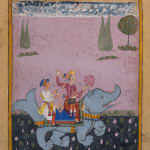-
Artworks
Gambhira putra, fourth 'son' of Sri Raga, from a Ragamala series
North Deccan, circa 1630-50
Opaque pigments and gold on paperThis eccentric but important series of Ragamala paintings have only recently been the subject of study, initially by Robert Skelton, and more recently by JP Losty. There is some stylistic...This eccentric but important series of Ragamala paintings have only recently been the subject of study, initially by Robert Skelton, and more recently by JP Losty. There is some stylistic debt to the dispersed and equally enigmatic North Deccan Ragamala of the late 16th century (Zebrowski 1983, nos 24-31 and Haidar and Sardar 2015, no13). The provenance of our series to the Northern Deccan in the first half of the 17th century seems certain. The spectacular and unusual colour combination is typical of the Deccan but the architecture can be found in Popular Mughal and early Rajasthani paintings which points to a hybrid style – a Hindu patron with links to the Rajput elements in the Mughal armies fighting in the Deccan, initially based at Burhanpur for the assault on Ahmadnagar and then at Aurangabad for that on Bijapur. JP Losty proposes a Rajput patron based at Aurangabad, perhaps specifically the main raga type in our series, the man with a small moustache and a wispy beard (JP Losty, 2022, p.54).
The series uses the Ragamala system established by Kshemakarna, the court poet of Rewa in Bundelkhand, where he wrote his Ragamala in 1570. In his system each of the six ragas has five wives and eight sons, our painting representing Sri Raga’s fourth son, Gambhira putra, who is usually identified by riding a sea monster.
Literature
Zebrowski,M. Deccani Painting 1983
Skelton, R. Ragamalas in the Deccan and what happens when ragas migrate without their texts in Glynn, C. et al ‘RAGAMALA Paintings from India from the Claudio Moscatelli Collection’, 2011
Haidar, N. and Sardar, M. Sultans of Deccan India: Opulence and Fantasy, 2015
JP Losty A Ragamala series from the north Deccan in ‘Court, Epic, Spirit – Indian Art 15th-19th century’, Francesca Galloway & Luhring Augustine 20221of 6



